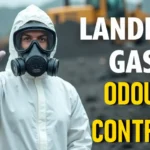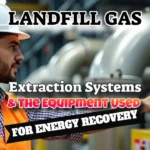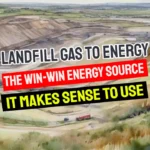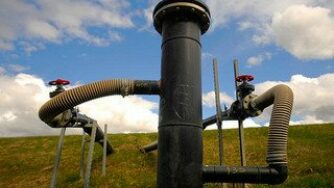 The landfill gas extraction pipework is the first element of all landfill gas recovery systems.
The landfill gas extraction pipework is the first element of all landfill gas recovery systems.
The purpose of the gas collection system is to extract the maximum possible volume of gas but to leave the condensate behind. Landfill gas is warm and saturated with water so it produces a lot of condensate as it passes through the cooler ground, once it leaves the waste.
The proprietary make of well head used by many of the United Kingdom's landfill operators monitors and regulates the gas flow from each well, and also contains a barometric leg for draining condensate away. The gas flow regulation device used is best if it is specified to be sleeve valve type, which provides much finer adjustment than a butterfly valve. This is especially the case at low flows, and most importantly this more expensive valve choice does not restrict the condensate as can a butterfly valve.
The well heads are installed in line on the lateral pipe system of the landfill gas extraction pipework. Choosing the correct diameter of pipe for the various sections of the system is of prime importance, since the velocity of the gas flow against the gradient of the pipe run is a critical factor in successful de-watering. Experienced landfill gas extraction pipework designers choose their pipe diameters according to experience and on some occasions from modelling the gas flow rates.
[box type=”note” style=”rounded” border=”full”]Note: The above video provides a means of calculating landfill gas collection pipe diameters for LFG Collection Projects.[/box]
Pipelines are carefully laid to falls from well to well, in order that the maximum amount of condensate is drained away via the well heads or other de-watering devices. The experienced landfill gas extraction pipework designer will assess the minimum fall according to the anticipated maximum settlement within the design life for the pipes. The fall will need to comfortably exceed the loss of height at the top of each pipe run after settlement and still provide a residual fall capable of allowing all condensate to continue to drain to the condensate collection points, also known as “knock-out pots”. if the designer fails to allow adequate falls in this manner, the landfill gas extraction pipework design will fail due to blockage of the horizontal interconnecting gas collection pipes when condensate water builds up.
It is a false economy to skimp on the number of individual pipelines used to transport the gas to the pumping station and generally better to have duplicate parallel pipe runs, rather than just one large diameter pipe collecting all of a field.
This gives flexibility which is necessary e.g. if repairs have to be carried out due to damage by machinery or settlement. It is also good practice to have the collection system divided in to sections. This is due to the fact that on an operational site it is sometimes necessary to remove and re-site sections of the collection system as filling of the site progresses, and if one pipe length of the landfill gas extraction pipework gets damaged at least part of the system will remain operational while repairs take place.
These are just a few of the considerations which a landfill gas extraction pipework designer must consider when designing the landfill gas extraction pipework for a landfill gas extraction system. It is recommended that all those seeking to install a landfill gas extraction and collection system engage an experienced designer, or a design and build contractor to do the design work.
Landfill Gas Extraction Well Design – An Introduction
It is important that all landfill gas extraction wells (also known as gas extraction boreholes) are designed carefully in accordance with best practice. In this article we have tried to identify the most important aspect of design. We also recommend the United Kingdom reader to consult the UK Environment Agency Publication, “Guidance on the Management […]
Best Practices in Odour Control Using Landfill Gas Extraction Systems
Landfill gas extraction systems effectively control odour by capturing and treating gases from decomposing waste. Proper system design, strategic well placement, and regular maintenance are crucial for minimizing fugitive emissions and odour complaints, with reductions of up to 85% achievable when these best practices are followed…
Landfill Gas Extraction Systems and the Equipment Used for Energy Recovery
In this article, we discuss landfill gas extraction systems and how the landfill gas collected is used to create renewable energy. Waste heat is used in a combined heat & power (CHP) system to improve overall efficiency. Landfill gas (LFG) is extracted from the landfill by exerting a small negative suction pressure on boreholes driven […]
Landfill Gas to Energy – The Win-Win Energy Source It Makes Sense to Use
Landfill Gas to Energy is truly a no-brainer renewable energy source (not to waste!), and in this article we explain why this is a fact. Unlocking Energy from Waste: The Power of Landfill Gas-to-Energy The Ingenious Cycle of Waste to Watts Transforming landfill gas into energy is not just a sustainable choice; it's a smart […]









Which is the best extraction pipe to use?
Can I get a complete drawings of a landfill gas extraction system for reference of an existing gas to energy project.Am an engineer from India.
Naveen
It would not be ethical for me as a professional landfill consultant to provide you with the drawings produced for another client. I am surprised that you ask such a question. Drawings are provided for each client and not publically available.
However, our “Introduction to Landfill Gas Extraction” ebook is available to buy from this website. If you buy it, the design requirements to enable you to design an LFG Extraction System are included. When you have bought it you can email me and ask further questions and I’ll reply with assistance, or if would like a 30-minute consultancy session to talk about the design on Skype or a similar platform I will provide that at no additional cost.
It’s a shame Algea cultivated in Photo Bio Reactors (PBR) isn’t employed to capture CO2 released by methane producers on a permanent basis. The carbon from the garbage will then be returned to the planet via fertiliser, compostable products, and other means.